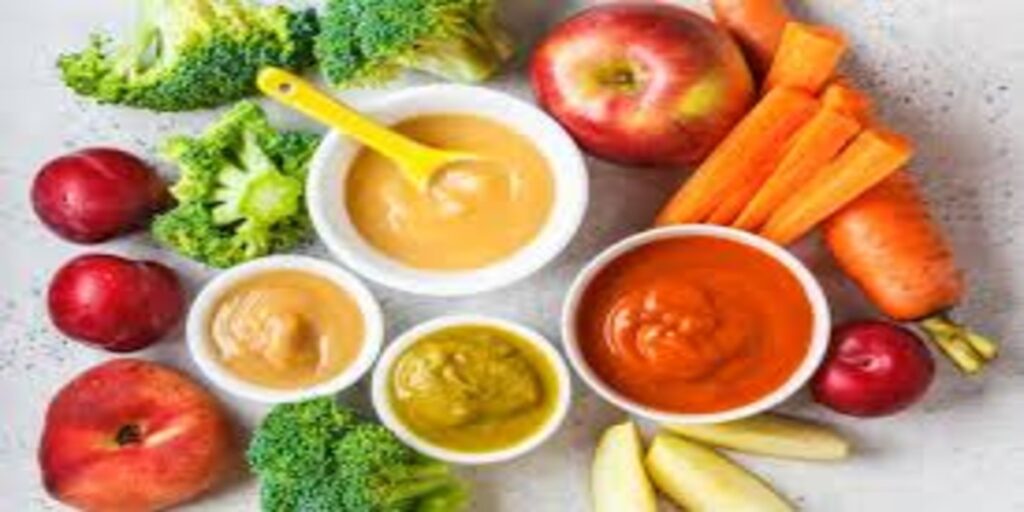7 Easy Ways to Make Homemade Baby Food
7 Easy Ways to Make Homemade Baby Food
Table of Contents

How to Make Homemade Baby Food: A Complete Guide
Welcome to Hamara Baby7 Easy Ways to Make Homemade Baby Food! As parents, ensuring our little ones receive the best nutrition is a top priority. Making homemade baby food is not only healthier but also cost-effective and simple. In this comprehensive guide, we will explore how to make homemade baby food, the benefits it offers, and some easy recipes to get you started. Let’s dive in!
Why Choose Homemade Baby Food?
When it comes to feeding your baby, homemade food has numerous advantages that make it a preferable choice for many parents:7 Easy Ways to Make Homemade Baby Food
1. Nutritional Control
One of the biggest advantages of making your own baby food is the ability to choose fresh, organic ingredients. When you make homemade baby food, you can ensure your little one is getting a balanced diet without unnecessary additives. Store-bought baby food often contains preservatives, added sugars, and other ingredients that may not be ideal for your baby’s health.7 Easy Ways to Make Homemade Baby Food
2. Cost-Effective
Buying pre-packaged baby food can add up quickly, especially if you plan to feed your child a variety of flavors and nutrients. Making your own baby food is not only cheaper but also more satisfying. You can buy fruits and vegetables in bulk and prepare larger batches, which can save you money in the long run.
3. Customization
Every baby is unique, and their tastes will vary. Homemade baby food allows you to tailor the flavors and textures to suit your baby’s preferences and dietary needs. If your baby dislikes peas, you can swap them for carrots or sweet potatoes. You can also adjust the consistency from smooth purees to chunkier textures as your baby develops.7 Easy Ways to Make Homemade Baby Food
4. Freshness
Homemade baby food is always fresh, made from ingredients that you’ve selected yourself. This freshness is crucial for maintaining the nutritional value of the food. Unlike store-bought options, which can sit on shelves for extended periods, homemade food retains its nutrients and flavors. Plus, you can experiment with seasonal fruits and vegetables, ensuring your baby enjoys the best of what nature has to offer.7 Easy Ways to Make Homemade Baby Food
5. Building Healthy Eating Habits
Introducing your baby to a variety of flavors and textures through homemade food can help cultivate healthy eating habits. It encourages your little one to explore different foods and develop a taste for wholesome ingredients. As they grow, this foundation can lead to healthier food choices later in life.7 Easy Ways to Make Homemade Baby Food
7 Easy Ways to Make Homemade Baby Food
Essential Ingredients for Homemade Baby Food
To get started on how to make homemade baby food, you’ll need a few basic ingredients. Here’s a breakdown of the types of foods you can include:7 Easy Ways to Make Homemade Baby Food
Fruits
- Apples: Packed with fiber and vitamin C, they can be easily blended into a smooth puree.
- Pears: A great choice for a naturally sweet flavor, perfect for introducing new tastes.
- Bananas: Soft and creamy, bananas are a convenient option that requires no cooking.
- Avocados: Rich in healthy fats, avocados provide essential nutrients and can be mashed easily.
- Peaches: Sweet and juicy, they can be pureed or served in small pieces once your baby is ready for texture.
Vegetables
- Sweet Potatoes: High in vitamins A and C, they are naturally sweet and easy to digest.
- Carrots: A rich source of beta-carotene, which is great for your baby’s vision and immune system.
- Peas: Full of protein and fiber, peas can be pureed for a smooth texture.
- Zucchini: Mild in flavor, zucchini is versatile and can be combined with other vegetables or fruits.
- Spinach: Packed with iron and vitamins, spinach can be blended with fruits for a nutrient boost.
Grains
- Rice: A common first food for babies; you can create rice cereal by cooking and blending.
- Oats: Rich in fiber and easy to prepare, oats can be served as a porridge.
- Quinoa: High in protein and gluten-free, quinoa can be cooked and blended for a smooth texture.
Proteins
- Chicken: A great source of lean protein; make sure to cook thoroughly before blending.
- Turkey: Another excellent protein choice that can be easily pureed.
- Lentils: Full of protein and iron, lentils can be cooked and blended into a nutritious puree.
These ingredients are nutritious, simple to prepare, and form the basis of a healthy diet for your little one.
Tools You’ll Need
Before we delve into recipes, ensure you have the following tools to simplify the process of making homemade baby food:7 Easy Ways to Make Homemade Baby Food
- Blender or Food Processor: For smooth purees. A handheld immersion blender is also a great option for easy cleanup.
- Steamer Basket: This allows you to steam vegetables without losing nutrients.
- Ice Cube Trays: Perfect for freezing portions, making it easy to serve the right amount each time.
- Storage Containers: Use airtight containers to keep your homemade baby food fresh. Glass containers or BPA-free plastic are both good choices.
7 Easy Ways to Make Homemade Baby Food
Step-by-Step Guide: How to Make Homemade Baby Food
Making homemade baby food can be a straightforward process. Here’s a step-by-step guide to help you get started:
Step 1: Choose Your Ingredients
Select fresh, ripe fruits and vegetables. Opt for organic when possible to avoid pesticides. Wash them thoroughly to remove any dirt or residues.7 Easy Ways to Make Homemade Baby Food
Step 2: Prepare the Ingredients
- Fruits: Peel and core as needed. Some fruits like bananas and avocados can be used raw.
- Vegetables: Peel (if necessary) and chop into small pieces for even cooking.
Step 3: Cooking
Steaming is the best method to preserve nutrients. Here’s how to steam vegetables:7 Easy Ways to Make Homemade Baby Food
- Fill a pot with water and bring it to a boil.
- Place the vegetables in a steamer basket over the boiling water.
- Cover and steam for about 10-20 minutes, or until tender.
You can also use boiling or roasting methods, but steaming retains more nutrients.
Step 4: Blending
Once the fruits or vegetables are cooked, transfer them to your blender. Add a little water, breast milk, or formula to achieve the desired consistency. Blend until smooth, adjusting the texture based on your baby’s age and ability to handle lumps.7 Easy Ways to Make Homemade Baby Food
Step 5: Storing
Pour the blended food into ice cube trays and freeze. Once frozen, transfer the cubes into labeled storage containers. They can last for up to three months in the freezer. Be sure to label each container with the date and type of food for easy identification.
7 Easy Ways to Make Homemade Baby Food
Easy Recipes for Homemade Baby Food
Now that you know the basics, let’s explore some simple recipes to get you started on making homemade baby food.
1. Sweet Potato Puree
Ingredients:
- 1 medium sweet potato
Instructions:
- Peel and chop the sweet potato into small cubes.
- Steam for 15-20 minutes or until tender.
- Blend with a little water until smooth.
2. Banana and Avocado Mash
Ingredients:
- 1 ripe banana
- 1 ripe avocado
Instructions:
- Mash the banana and avocado together in a bowl until smooth.
- Serve immediately for a nutritious snack or meal.
3. Pea Puree
Ingredients:
- 1 cup fresh or frozen peas
Instructions:
- Steam peas for about 5 minutes until tender.
- Blend until smooth, adding water as needed to reach the desired consistency.
4. Apple and Pear Sauce
Ingredients:
- 1 apple
- 1 pear
Instructions:
- Peel and chop the fruits.
- Steam until soft (about 10 minutes).
- Blend until smooth for a delicious fruit puree.
5. Chicken and Vegetable Puree
Ingredients:
- 1 small chicken breast
- 1 carrot
- 1 zucchini
Instructions:
- Cook chicken thoroughly, then chop into small pieces.
- Steam the carrot and zucchini until tender.
- Blend the chicken with the vegetables, adding water to achieve a smooth consistency.
6. Quinoa and Vegetable Mash
Ingredients:
- 1/2 cup cooked quinoa
- 1/2 cup steamed spinach
- 1/2 cup cooked carrots
Instructions:
- Combine all ingredients in a blender.
- Blend until smooth, adding water as needed.
7. Mango and Rice Pudding
Ingredients:
- 1 ripe mango
- 1/2 cup cooked rice
Instructions:
- Peel and chop the mango.
- Blend the mango with the cooked rice until smooth.
- Add water or breast milk for a creamier texture.
Storage Tips for Homemade Baby Food
Freezing
Freezing is one of the best ways to preserve homemade baby food. Use ice cube trays to portion out the purees. Once frozen, pop the cubes out and store them in airtight containers or freezer bags. This method not only saves space but also allows you to quickly thaw the exact amount needed.7 Easy Ways to Make Homemade Baby Food
Thawing
To thaw homemade baby food, place the container in the fridge overnight or use the microwave on a low setting. Always stir well before serving to ensure even heating. Avoid refreezing any food that has been thawed.7 Easy Ways to Make Homemade Baby Food
Checking Consistency
Before serving, make sure the food is smooth and free from lumps. You can use a sieve to strain out any remaining chunks for younger babies who are just starting with solids.7 Easy Ways to Make Homemade Baby Food
FAQs
1. When can I start making homemade baby food?
Most babies are ready for solid foods around 6 months old. You can start with single-ingredient purees and gradually introduce new foods.
2. Can I freeze homemade baby food?
Yes, homemade baby food can be frozen in ice cube trays for easy portioning. Just ensure to store them in airtight containers to prevent freezer burn.
3. How do I know if my baby is ready for solids?
Signs of readiness include showing interest in food, sitting up well with support, and the loss of the tongue-thrust reflex. If your baby seems curious about what you’re eating, it’s a good sign!
4. Are there any foods I should avoid?
Yes, avoid honey until your baby is at least one year old, as it can cause botulism. Additionally, steer clear of foods that are choking hazards, such as whole nuts and grapes.
5. How long does homemade baby food last?
In the fridge, homemade baby food lasts about 3 days. In the freezer, it can last up to 3 months. Always check for changes in color, texture, or smell before serving.
6. Can I use spices in homemade baby food?
Once your baby is accustomed to plain foods, you can gradually introduce mild spices for flavor. Start with small amounts to see how your baby reacts.
7. How do I introduce new foods?
Introduce one new food at a time and wait 3-5 days before trying another. This helps monitor for any allergic reactions or sensitivities.



